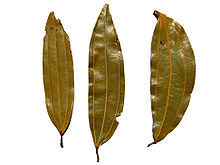
Back ساذج هندي Arabic ساذج هندى ARZ তেজপাত Assamese Cinnamomum tamala AST Cinnamomum tamala Azerbaijani তেজপাতা Bengali/Bangla Malabathrum Catalan Cinnamomum tamala CEB Indisches Lorbeerblatt German Cinnamomum tamala Spanish
| Indian bay leaf | |
|---|---|

| |
| Semi-dried Indian bay leaves | |
| Scientific classification | |
| Kingdom: | Plantae |
| Clade: | Tracheophytes |
| Clade: | Angiosperms |
| Clade: | Magnoliids |
| Order: | Laurales |
| Family: | Lauraceae |
| Genus: | Cinnamomum |
| Species: | C. tamala
|
| Binomial name | |
| Cinnamomum tamala | |
| Synonyms[2] | |
Cinnamomum tamala, Indian bay leaf, also known as tejpat,[3] tejapatta, Malabar leaf, Indian bark,[3] Indian cassia,[3] or malabathrum, is a tree in the family Lauraceae that is native to India, Bangladesh, Nepal, Bhutan, and China.[3] It can grow up to 20 m (66 ft) tall.[4] Its leaves have a clove-like aroma with a hint of peppery taste; they are used for culinary and medicinal purposes. It is thought to have been one of the major sources of the medicinal plant leaves known in classic and medieval times as malabathrum (or malobathrum).[5]
- ^ Glossary of Indian Medicinal Plants
- ^ "The Plant List: A Working List of all Plant Species".
- ^ a b c d "Cinnamomum tamala". Germplasm Resources Information Network. Agricultural Research Service, United States Department of Agriculture. Retrieved 12 December 2017.
- ^ Xi-wen Li, Jie Li & Henk van der Werff. "Cinnamomum tamala". Flora of China. Missouri Botanical Garden, St. Louis, MO & Harvard University Herbaria, Cambridge, MA. Retrieved 29 March 2013.
- ^ Umberto Quattrocchi (2016). CRC World Dictionary of Medicinal and Poisonous Plants: Common Names, Scientific Names, Eponyms, Synonyms, and Etymology (5 Volume Set). CRC Press. pp. 959+. ISBN 978-1-4822-5064-0.
© MMXXIII Rich X Search. We shall prevail. All rights reserved. Rich X Search